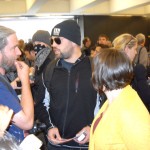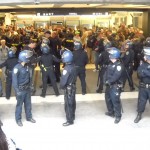
Scene at BART protest Thursday in San Francisco

Kristof talks to the press
KCBS radio in San Francisco, on the evening of Thursday September 8, 2011, reported that numerous arrests were made at the No Justice No BART demonstration at the Powel station and that journalists had been among the arrestees.
Since it is newsworthy that the demonstration ended in numerous arrests and since it is unusual for journalists to be included in among the arrestees, there will be a demand for accounts of what happened there on the evening of September 8, 2011.
This will be a subjective report from a fellow who was there trying to simultaneously function as a photojournalist and a writer covering the events.
One of the habits we accumulated back in the Seventies when we did some paparazzi style photography, we would make it a point to take a moment and check to see if, when all cameras were pointing in one direction, it would make a good shot to turn around and look in the opposite direction. There is a tendency among photographers to flock to “the shot.” (We remember one Lakers game where the L. A. Times, the L. A. Herald Examiner, the Long Beach paper, and AP Photo all featured a shot of the same play.) If you can break yourself of the habit of becoming obsessed with following the crowd, you might get a distinctly different photo by turning in the other direction.
Since we have that habit, and since we don’t have a press pass, we made it a point to take a look around as the demonstration story was developing. We didn’t think it would be a good idea to be caught in a round-up if we didn’t have a press pass. There was a massive police presence on the perimeter. (We even noticed that the large contingent of San Francisco and BART police had been augmented by some officers from the Homeland Security agency this time.)
Younger journalists tend to favor getting close to the center of the activity and using a wide-angle lens to illustrate stories about a particular event. Older photographers tend to want to get an overall shot from above the edge of the crowd to have a different perspective on the images being produced.
A close up shot of one particular protester with one particularly eloquent sign may summarize the event. Conversely, if an overall shot shows that there was only two people participating in the protest and that there was a gigantic mob of media surrounding them, that tells the story a bit more accurately.
On Thursday in San Francisco, there was a contingent of journalists that indicated assignment editors around the city expected an important story to develop.
Since we have covered similar stories earlier in the year, we recognized some of the protesters as well as some of the police commanders.
At first the story seemed to be a routine demonstration one. Then we noticed that some on the gates to the station were being closed indicating that access in and out of the area was being restricted.
We decided to go outside and see if we could get some of the photos in the “overview” category.
As previously, mobs of people with video and still photo equipment were trying to get very close to the center of the activity.
Outside the station we observed more police arriving.
According to a report heard later that evening on KCBS, the police announced that it was an illegal assembly inside the building and that people and newsmen were being asked to vacate the premises. The KCBS reporter, Mike Fillipe, noted that he heard the announcement advising journalist to leave, so he did. It is unclear if the other journalist heard the announcement and chose to ignore it or if they didn’t hear it.
Outside the station, protesters and bystanders occasional chanted urging the police to “let them go” or “let her go.” We heard rumors that examples of police brutality had occurred but since we didn’t see (or get photos) such conduct that provided us only with an example of how unsubstantiated rumors play a role in such events.
There was a flurry of activity produced by a loud debate between some citizens.
Gradually the number of observers outside the station diminished and we determined that it was time to go elsewhere and get a bus back to Berkeley CA.
If journalist were actually included among the arrestees, various journalism groups such as the folks at the Columbia Journalism Review web site and the people who run the American Journalism web site will become interested in the long term implications of the arrests of working journalists and they will try to monitor a large number of accounts of what transpired in an effort to piece together an overall view of what happened and why.
If news publications such as Time and Newsweek magazines become interested in doing a story about this particular No Justice No BART protest, they will have to use photos provided by photo agencies or new services such as AP Photo and do their own stories based on police reports and the available stories from journalist who were there.
For journalism students at various institutions of higher learning in the San Francisco Bay area, Thursday’s events provided a noteworthy example of gathering valuable experience while working at the student publication level. Perhaps some will be able to do freelance articles and add valuable tearsheets to their portfolio.
For a photographer/writer who covered the Thursday event seeking material to post on several web sites, the event produced numerous adequate shots and several topics which might be expanded into columns or column items in the days to come.
If the World’s Laziest Journalist spends any time reviewing the other coverage of the event in the hopes of revisiting this particular protest in future columns, he will loose the time and opportunity to search for yet more recent news as it is happening and thereby seem to be a shoddy example of citizen journalism in action.
If, on the other hand, the World’s Laziest Journalist posts some photos and a perfunctory subjective report on Thursday’s event and then proceeds onwards to other topics and news stories, he will be open to allegations of shoddy and slapdash methodology. It’s what TV folks call the “Q and D” (Quck and Dirty) approach to journalism.
Is it any wonder that a lot of journalists are perceived by their friends to be total nihilists?



Is “boring news event” an oxymoron?
Tourists who visited San Francisco on the afternoon of Monday September 19, 2011 were rewarded with a warm (Indian Summer?) day with clear blue sky that provided snap-shot shooters with postcard perfect conditions that brought Paul Simon’s song “Kodachrome” to mind. You don’t have to speak their language to know when a skyscraper has impressed some foreign travelers.
News Photographers who were at San Francisco’s BART Civic Center station to cover this week’s installment of the regularly scheduled No Justice No BART political demonstrations came away from the event with images that might have disappointed many of the photo editors in the area because the latest protest did not disrupt BART service and no arrests were made.
Pictures of the protesters handing out leaflets outlining their assertions about the BART Police Department made it seem like the demonstrators have achieved celebrity status and their efforts naturally drew a contingent of paparazzi to record their everyday activities for posterity.
The very fact that any blogger covering Monday’s “demonstration” has to ask if images of some mundane advocacy efforts are newsworthy may indicate that digital journalism is mature enough to face the same question that have been being asked at city desks for years: what is new?
According to hearsay evidence the concept of digital images was developed by some computer pioneers who worked on the second floor of their building and wanted to be able to tell if the coffee maker on the first floor had finished its chore. If those images are still available, they will have some historic value.
When Mario Savio leaped into the headlines with an extemporaneous speech almost fifty years ago, the citizens in Berkeley had a specific example that a cusp area where political activism and celebrity often overlap does exist.
The aim of political activists is to draw attention to a specific cause and so spokespersons faces a double edge sword when they start to become a certified celebrities. They can draw massive news coverage but they also risk drawing attention away from the cause they are working to achieve.
Meanwhile bloggers have to start thinking like photo editors.
If there are approximately three dozen people who cover activists handing out flyers does that mean that the photos have news value?
If bloggers are becoming concerned with questions of news value is that evidence that the phenomenon of citizen journalism is maturing?
Local TV stations have been accused of adopting an “if it bleeds; it leads” philosophy of journalistic judgment.
If a local event doesn’t produce eye catching dramatic images does it deserve play?
If the Internets are providing a venue for citizen journalists to cover issues that the national media ignore, doesn’t that mean that protests that don’t result in mass arrests deserve coverage?
Are the No Justice No BART protests getting coverage on Fox Views (AKA Fox News) Network?
What if the next No Justice No BART demonstration features an adorable kitten playing the Kingston Trio’s song “(Charlie on the )MTA” on a piano? Would an online video of that “go viral”? Would it be newsworthy? Would folks fwd that to their friends on Facebook? Would it help publicize the effort to disband the BART cops?
When it becomes obvious that without a large number of arrests an event loses news value, then some home-truth aspects of journalism start to become apparent.
Maybe before covering the next No Justice No BART event, we should read the classic short story “The Lady or the Tiger” to see if there is some subtle journalistic symbolism in it?